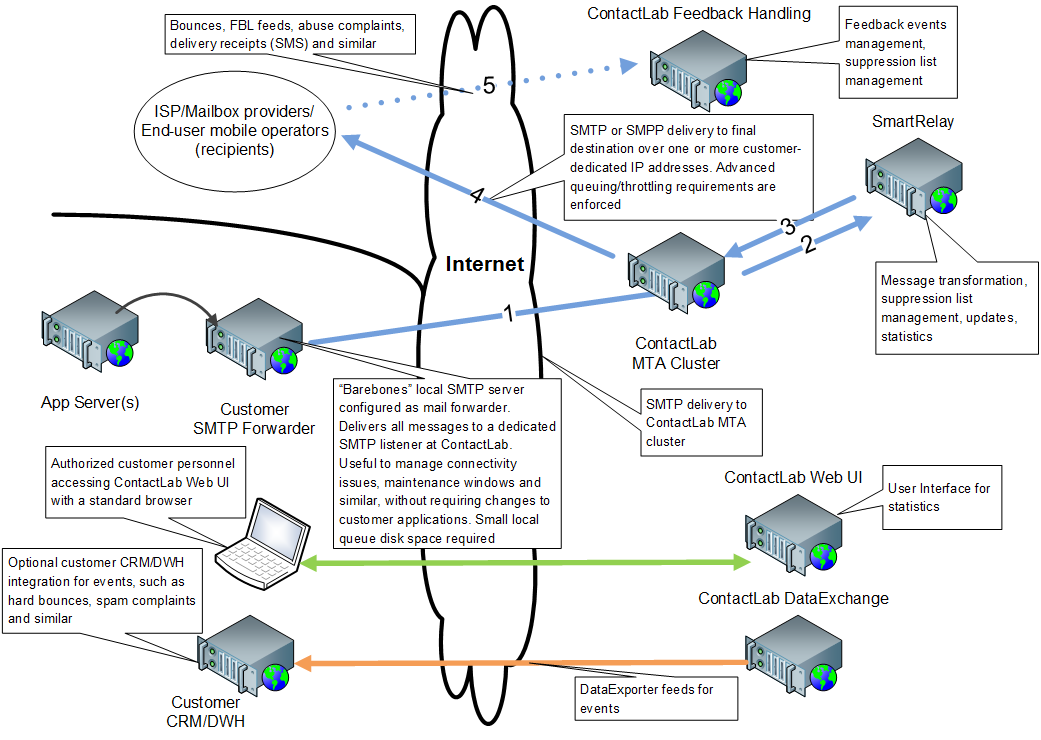SmartRelay overview

The SmartRelay conceptual architecture
SmartRelay combines a range of components and features to provide an effective solution for sending SMTP-based email and SMS messages.
Your local environment
The above diagram and the following descriptions assume that you have set up a local SMTP forwarder as recommended, to act as the outgoing message interface between your application servers and the Contactsend SmartRelay injection point. See using a local SMTP forwarder for more details.
SMTP injection point
The MTA Cluster is the SMTP injection point on the Contactlab side, which provides your environment with access to SmartRelay (#1 in the above illustration).
IP addresses and the SMTP listener
We reserve an IP address for you, which a dedicated SMTP listener monitors for incoming SMTP connections from the pre-authorized IP address(es) that you provide. Each SMTP listener is configured to allow a maximum number of simultaneous inbound SMTP connections. See Maximum number of simultaneous SMTP sessions for more details.
Local SMTP forwarder
We recommend that you use a small SMTP forwarder to accept messages from your application servers and forward them to the SMTP injection point. See using a local SMTP forwarder for more details.
SmartRelay engine
The MTA Cluster sends all accepted messages to the SmartRelay engine (#2 in the above illustration), which does the following:
- Email messages:
- Each message is re-wrapped and returned to the MTA Cluster for delivery to its final destination (#3 in the above illustration)
- SMS messages:
- Each message is converted from the received plain text email and returned to the MTA Cluster for delivery to the appropriate SMS network (#3 in the above illustration)
In case of support, remember that SmartRelay returns a unique code useful for precise checks in every communication.
Here is an example of an answer:
250 2.0.0 OK 79/BC-12331-5C348706
Where 79/BC-12331-5C348706 is the unique code that identifies the communication.
Outbound email over SMTP
The MTA Cluster:
- Applies all mandatory and optional queuing parameters, based upon:
- General throttling agreements
- Any specific destination domain requirements
- Any specific customer configuration requirements agreed with the Contactlab deliverability team
- Sends each message to its destination (#4 in the above illustration)
By default, the dedicated IP address that we give to you (see IP addresses and the SMTP listener above) is used to send email messages.
Inbound and outbound queue management is kept entirely separate.
Outbound SMS using the SMPP protocol
The MTA Cluster sends each message to its destination using the standard SMPP protocol. The best available routes to the destination SMS network are applied according to a number of factors, including contractual requirements.
Feedback handling
The following are managed by Contactsend, without you needing to configure any parameters (#5 in the above illustration):
- Bounces
- SMS delivery reports
- Feedback loop reports
- List-unsubscribe processing
- Abuse complaints
- View and link tracking, if configured
- Unsubscribe management, if configured
Web UI
You can use either the standard Contactsend Web UI, or the specially developed SmartRelay Web UI, to quickly diagnose any problems, access statistics and similar.
DataExporter
If you have requested the optional DataExporter feed, we automatically export event-related raw data, such as bounces, complaints, clicks and similar, and make it available:
- On a server that belongs to youor:
- In a private area assigned to you, on our serversAvailable according to your agreement with Contactlab.
See the DataExporter documentation, which is available on request from Contactlab customer care, for more details.